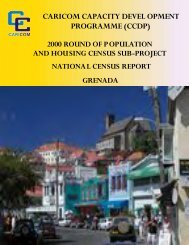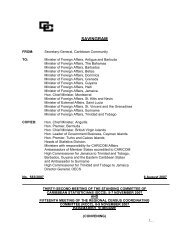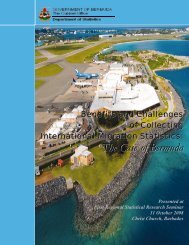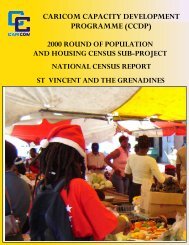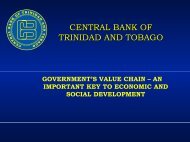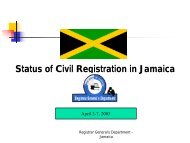Women and Men in the Caribbean Community
Facts and Figures, 1980-2001 - CARICOM Statistics
Facts and Figures, 1980-2001 - CARICOM Statistics
You also want an ePaper? Increase the reach of your titles
YUMPU automatically turns print PDFs into web optimized ePapers that Google loves.
Chapter 6: DATA REQUIREMENTS AND GAPSInstitutionalis<strong>in</strong>g <strong>the</strong> Compilation <strong>and</strong> Dissem<strong>in</strong>ation of Gender-sensitive IndicatorsAt national <strong>and</strong> regional levels, it is important to cont<strong>in</strong>ue <strong>the</strong> process that has begun, <strong>and</strong> toidentify appropriate <strong>in</strong>dicators <strong>and</strong> data sources to illum<strong>in</strong>ate given issues. A review of <strong>the</strong>seissues <strong>and</strong> <strong>the</strong> relevant <strong>in</strong>dicators would be needed periodically to take <strong>in</strong>to account emerg<strong>in</strong>gissues <strong>and</strong> achievements <strong>in</strong> areas of concern. The review will take stock of:• currently available data <strong>and</strong> assessment of quality;• desirable <strong>in</strong>dicators based on available data;• data required to fill gaps <strong>in</strong> <strong>the</strong> data;• process for collect<strong>in</strong>g required data <strong>and</strong> develop<strong>in</strong>g new <strong>in</strong>dicators.The process will also seek to evolve a susta<strong>in</strong>able system capable of monitor<strong>in</strong>g <strong>the</strong> progressof women <strong>in</strong> <strong>the</strong> Region, lead<strong>in</strong>g to <strong>the</strong> regular production of a statistical publication ongender, which presents <strong>and</strong> <strong>in</strong>terprets topical data on women <strong>and</strong> men <strong>in</strong> a form suitable fora wide range of non-technical users, as recommended <strong>in</strong> <strong>the</strong> Beij<strong>in</strong>g Platform for Action(United Nations, 1995; para. 207[a]).Draw<strong>in</strong>g on hard data to confirm perceptions or anecdotes of gender <strong>in</strong>equities can provide<strong>the</strong> much-needed support for efforts to deal with <strong>Caribbean</strong> gender concerns. Incisive <strong>and</strong><strong>in</strong>sightful analysis <strong>and</strong> <strong>in</strong>terpretation of <strong>the</strong> data should <strong>in</strong>fluence national <strong>and</strong> regional decision-mak<strong>in</strong>g<strong>and</strong> plann<strong>in</strong>g, br<strong>in</strong>g<strong>in</strong>g greater sensitisation, fund<strong>in</strong>g, education, tra<strong>in</strong><strong>in</strong>g <strong>and</strong>capacity-build<strong>in</strong>g to programmes <strong>and</strong> projects that target women <strong>and</strong> youth. It can also affordopportunities for governments to make more <strong>in</strong>formed decisions. In addition, it can expose<strong>the</strong> myth of exist<strong>in</strong>g <strong>and</strong> emerg<strong>in</strong>g gender concerns as “imported fem<strong>in</strong>ist ideas,” <strong>and</strong> beg<strong>in</strong><strong>the</strong> real work of end<strong>in</strong>g women’s marg<strong>in</strong>alisation; <strong>in</strong>creas<strong>in</strong>g opportunities for women’scontribution to nation-build<strong>in</strong>g; ma<strong>in</strong>stream<strong>in</strong>g gender <strong>in</strong> decision-mak<strong>in</strong>g, plann<strong>in</strong>g <strong>and</strong>implementation; <strong>and</strong> <strong>in</strong>stitutionalis<strong>in</strong>g women’s social, cultural, economic <strong>and</strong> political value.It dem<strong>and</strong>s <strong>the</strong> streng<strong>the</strong>n<strong>in</strong>g of national statistical offices <strong>and</strong> regional data collection strategies,especially with respect to gender differentials.In <strong>the</strong> f<strong>in</strong>al analysis, however, it is <strong>the</strong> dissem<strong>in</strong>ation <strong>and</strong> utilization of gender-sensitive data<strong>and</strong> statistical reports that rema<strong>in</strong> critical to <strong>the</strong> process of correct<strong>in</strong>g gender imbalances <strong>and</strong>build<strong>in</strong>g equitable <strong>and</strong> susta<strong>in</strong>able societies for all. This dissem<strong>in</strong>ation must reach beyondbureaucrats <strong>and</strong> adm<strong>in</strong>istrators to a wide cross-section of schools, community activists <strong>and</strong>ord<strong>in</strong>ary women <strong>and</strong> men, <strong>in</strong> order to br<strong>in</strong>g a deeper <strong>and</strong> more direct underst<strong>and</strong><strong>in</strong>g of community<strong>and</strong> national challenges, <strong>and</strong> to motivate personal <strong>and</strong> direct action <strong>in</strong> communitydevelopment <strong>and</strong> nation-build<strong>in</strong>g.127




